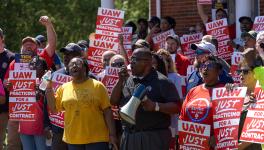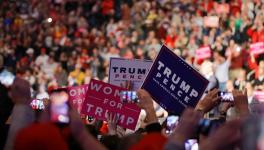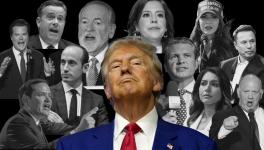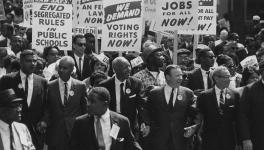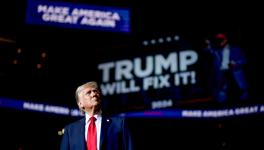Korean Handshake

On Friday, the leaders of North and South Korea will meet in the village of Panmunjeom (South Korea). It is the first time that a leader from the North has been across the De-Militarised Zone (DMZ). Two previous South Korean presidents – Kim Dae-jung and Roh Moon-hyn had met with Kim Jong-il, the father of the current leader of North Korea in 2000 and 2007 respectively. But they met in North Korea. Both those summits did not result in any major shifts of direction.
It is important to register that there is no peace treaty between the two Koreas for a war that has largely been over since 1953 (for background on the crisis in the Korean peninsula, see the Tricontinental dossier here). At the 2000 and 2007 summits, the question of ending the war was on the table. It did not go very far. There is expectation that an end to the war might be on the table this week. The journey of Kim Jong-un to Panmunjeon is, therefore, of great significance.
Sunshine Policy.
As significant is the fact that just after South Korean President Moon Jae-in was sworn into office, North Korea fired a test volley of ballistic missiles. Disregarding that test, Moon Jae-in put into office two key people with long-standing histories of attempting to bring the two Koreas close together – Prime Minister Lee Nak-yeon and intelligence chief Suh Hoon. Despite pressure on Moon Jae-in to avoid the ‘Sunshine Policy’ of rapprochement between the two Koreas from Washington, DC, Tokyo and sections of the South Korean establishment, he went ahead with the policy.
North Korea’s government pushed ahead with what appeared to be a belligerent missile and nuclear test timetable. With the US President Donald Trump reacting with warlike noises, it appeared as if war was indeed on the horizon on the peninsula. What the Americans did not calculate is that the North Koreas were less interested in war than in ensuring that they would have a good bargaining position when they eventually came to the table with the South.
Nuclear Umbrella.
It was an intelligent decision by the North Koreans to announce last week that they would shutter the Punggye-ri nuclear site. This made it appear as if they were serious about an end to the nuclear tension in the peninsula. In fact, the North Koreans had made this gesture in November, but no-one was paying any attention. The site is itself already spent. It is unlikely that a test could have been conducted at the site in the future. But the North Korean statement produced the expected result – letting the world know that the North was willing to make concessions on the nuclear front.
In fact, as North Korean diplomats say, the North is not willing to surrender its nuclear arsenal. They mention the case of Libya, whose leader Muammar Qaddafi gave up his nuclear shield and then watched as his country was destroyed by a NATO war. But the North Koreans are not willing to take the word of Washington of any deal. They watch Trump’s statements regarding the Iran deal as clarification that there is no trust in a handshake with Washington. What is more likely than de-nuclearization is that the North and South might convert the armistice since 1953 into a peace treaty and increase the level of cooperation across the DMZ.
American Power.
But would a peace treaty between North and South Korea be sufficient? After all, one of the belligerent parties here is the United States. It was the US that participated in the war from 1950 to 1953. US bases with about 35,000 troop litter South Korea, while about 40,000 more US troops are based in Japan. US warships and aircraft with nuclear capability constantly cross the seas and air around the North. If Washington does not participate in the ending of the war, then the war is not going to truly end. This is a serious problem for Moon Jae-in. He cannot sign on behalf of the United States.
South Korea’s Foreign Minister Kang Kyung-wh met with Susan Thornton – Trump’s nominee for the State Department post on East Asian and Pacific Affairs. South Korea’s Lee Do-hoon – of the inter-Korean peace negotiation division – met with Kanasugi Kenji of Japan’s Ministry of Foreign Affairs. Both these meetings were to assure the Americans and the Japanese that the South Koreans see these discussions as part of a process which must not be scuttled. There might not be a spectacular and meaningful outcome of Friday’s meeting, but it should be seen as significant for its occurrence.
Get the latest reports & analysis with people's perspective on Protests, movements & deep analytical videos, discussions of the current affairs in your Telegram app. Subscribe to NewsClick's Telegram channel & get Real-Time updates on stories, as they get published on our website.












